Modern marketers are tasked with a daunting challenge. They must balance the needs and priorities of the customers (love) with those of the business shareholders (money). In other words, they must strive to meet and exceed the expectations of empowered customers while adding shareholder value by providing positive (and quantifiable) results through their activities.
This report highlights the conundrum of balancing the needs of the shareholders and the customers and how top performing CMOs are able to overcome this challenge by using journey management, omni-channel, and analytics as key ingredients of their activities.

Bridging the gap between love (the customers) & money (the shareholders) are top priorities for CMOs.
Between January and March of 2015, Aberdeen Group surveyed 207 businesses regarding the key trends and activities influencing customer experience management (CEM) and marketing programs. The findings revealed that modern marketers must straddle two different sets of expectations.
Company shareholders expect the business to provide additional value, and have little patience to wait on the long-term benefits of a strategy — rather; it expects to see strong results in the short-term. The customers, on the other hand, expect the business to prioritize their needs above anything else.
Figure 1 shows that CMOs are under pressure to incorporate (and align) the expectations of both customers and shareholders with their activities to resolve this dilemma.
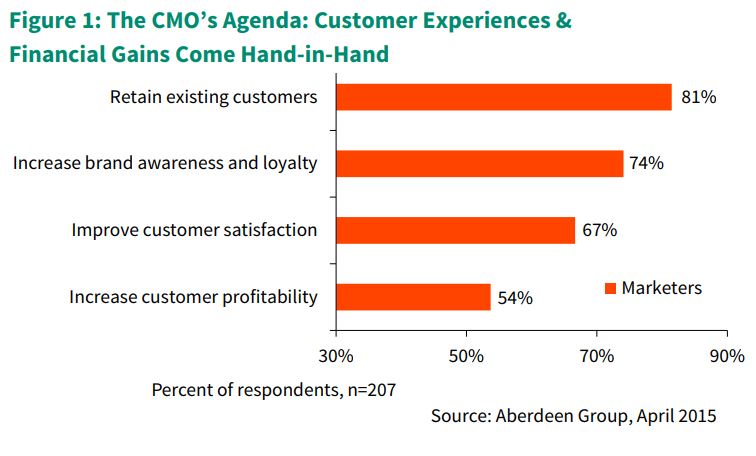
“CMOs are split between the customer’s demands for more personalised and timely customer experiences and shareholder expectations for positive financial results. Bridging this gap is no easy feat, however, it is one that savvy CMOs achieve.”
Survey participants comprised firms in business-to-business (B2B), business-to-consumer (B2C) and mix-model (B2B and B2C as well as B2B2C) organisations.
Marketing practitioners across different levels within the business participated in the study. Fifty-nine percent of these marketers represent senior management and decision makers, while 41% represent marketing operations staff, which provides us with a complete view of the strategic priorities of marketers as well their experiences when executing on their plans.
Specifically, Findings in the above figure indicate that retaining existing buyers is top of mind for the CMO. Since unhappy consumers are more likely to stop doing business with an organisation, improvement in customer retention rate is a reflection of a firm’s success. However, retention rates are also a leading indicator of an organisation’s financial performance.
When a business loses customers, it needs to make up for the lost revenue by growing the wallet share of existing accounts and/or spending more on marketing campaigns to acquire new buyers. Both of these activities result in additional costs, which have an effect on profitability, affecting the expectations of shareholders.
Also, important to note in Figure 1, is the CMO’s goal of improving customer profit margins. This refer to maximising the value of each account by minimising marketing costs and increasing spend with each buyer. Similar to customer retention rates, profitability is a measure that represents success in bridging the gap between customer expectations and financial outcomes. To maximise profitability, marketers must understand and address the precise needs of the customers. They must also ensure that their activities are executed seamlessly in order to delight the shareholders with reduced costs and increased buyer spend. In short, CMOs must create happy and satisfied customers who spend more, resulting in less company spend on marketing to acquire new accounts, saving money for the business, or allowing the business to invest in other initiatives.
Now that we’ve uncovered how the divide between the shareholders and the customers influences the CMO’s agenda, let’s observe the struggles companies face in mitigating this challenge.
Marketers Struggle with Managing the Customer Journey
The modern buyer/seller conversations are best represented in the form of a journey. In fact, Aberdeen’s March 2015 CEM Executive’s Agenda 2015: Leading the Customer Journey to Success study shows that companies use an average of four channels through the course of customer conversations, from raising awareness to cross-sell/upsell and loyalty. Customer expectations at each phase of these interactions can vary. Therefore, meeting the needs of the customers requires modern marketing leadership to stay in-tune with those changes and adapt marketing activities accordingly. Table 1 below shows that timely and deep understanding of buyers needs is the top challenge keeping marketing leaders up at night.
“Understanding the rapidly changing needs of empowered customers is the top challenge keeping CMOs up at night.”

Findings from the March 2015 Big Data in CEM: The Path to Productive Employees & Happy Customers study sheds light into why marketers are challenged with managing the customer journey. It shows that currently, 96% of marketers are not satisfied with their ability to use existing data when designing marketing programs to orchestrate buyer journeys. Overcoming this challenge and understanding where, when, and how the current customer conversations evolve should be a key focus for marketing leaders. Indeed, those who mitigate this challenge by better utilising historical and real-time data are well-positioned to guide marketing programs to identify and address evolving buyer needs. This helps them satisfy the customers as well as drive positive financial results through happy customers, hence meet the expectations of the shareholders.
Definitions:
- Customer Experience Management (CEM): a continuum of business activities executed on an enterprise level to interact with buyers via different channels and devices throughout the entire customer lifecycle.
- Journey Management: a set of customer/company conversations taking place across numerous channels where the nature/context of interactions are unique. The customer lifecycle is made up of numerous journeys. Each phase in the customer lifecycle can be considered a unique journey. For example, when organisations are looking to raise awareness for their products/services, potential buyers interacting with the firm are taken on an ‘awareness’ journey. Similarly, after closing a sale, companies take buyers through an ‘onboarding’ journey. For the purposes of this research, we use the term ‘customer journey’ and ‘buyer journey’ synonymously.
The Benefits of Journey Management in Modern Marketing
When executed effectively, journey management is a powerful activity that helps marketers attain the short-term and financial expectations of the shareholders, as well as meet and exceed the rapidly changing demands of customers. Figure 2 illustrates that marketers orchestrating buyer journeys outspace competitors across several key metrics, including return on marketing investments (ROMI) and revenue from customer referrals.
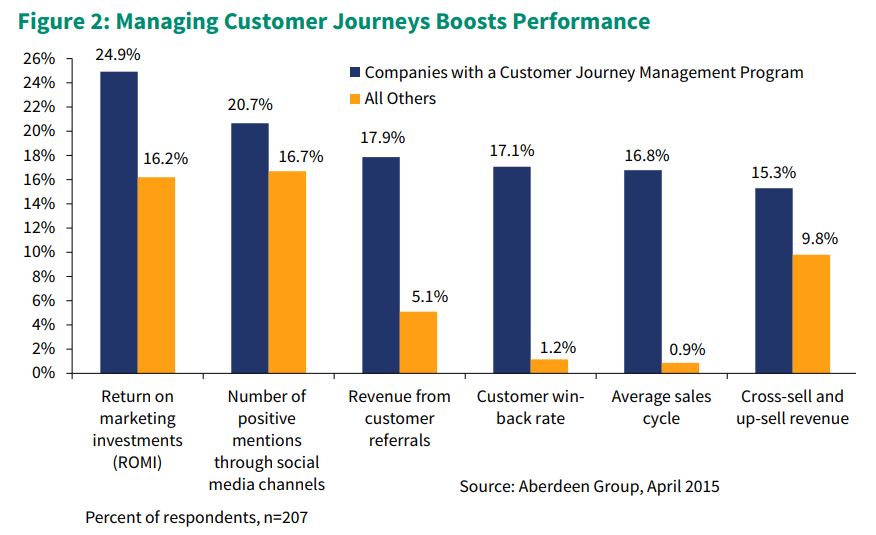
It’s important to note that the performance results depicted above provide an illustration of the benefits of adopting a formal journey management program. Marketers are already managing different phases of buyer/seller interactions, from raising awareness of a product via multi-touch campaigns to retargeting existing buyers for cross-sell and upsell opportunities. However, when those activities are executed in an ad-hoc fashion, marketing performance can suffer. This is where establishing a formal program to manage customer journeys comes in. Marketing leaders and CMOs who design and incorporate a customer journey management strategy as part of their overall activities enjoy a 54% greater annual improvement in ROMI, compared to All Others (24.9% vs. 16.2%). ROMI is a metric that well represents a marketer’s ability to satisfy the shareholders. Hence, we can state that CMOs with a sound journey management strategy are able to meet the expectations of the shareholders. But, what about the customers; how does journey management help on that end?
Marketers successfully using journey management increase revenue from customer referrals by more than 3-times, compared to All Others (17.9% vs. 5.1%). Driving referral revenue is no easy feat. It is a true testament of an organisation’s ability to satisfy buyers so much so that they become evangelists of the company brand, products/services and encourage their own networks to become customers. From that perspective, the drastic difference between the performances of CMOs with a sound journey management strategy versus ALL Others validates that the former also satisfies the customers.
An interesting observation related to the results illustrated in Figure 2 is the number of positive social media mentions (buzz) enjoyed by journey management users. Aberdeen’s August 2014 Social Customer Care: Steps to Success in 2014 study noted that social media serves as a lever to amplify the positive or negative sentiment about a brand. It indicated that when used effectively, social media helps firms strengthen connections with their buyers. The performance results of CMOs with a journey management straetgy indicate that they also excel in utilising social media as an enabler to bond with customers.
While we’ve learned that a sound journey management strategy helps CMOs bridge the gap between love and money, we also noted that marketers face a series of challenges impacting their ability to successfully manage buyer journeys. Let’s now take a look at how top performing CMOs tackle these challenges.
Requirements To Successfully Orchestrate a Customer Journey
The first step in mapping and managing the customer journey is streamlining customer data management. This refers to an organisation’s ability to seamlessly capture, store, analyse and use customer data to support marketing campaigns executed across numerous channels. Aberdeen’s Big Data in CEM study shows that 96% of marketers are not satisfied with their ability to use customer data. However, there is a leading group of CMOs, named as Best-in-Class, who overcome this challenge and enjoy the performance results outlined. Figure 3 Provides a view of their activities to accomplish these results.
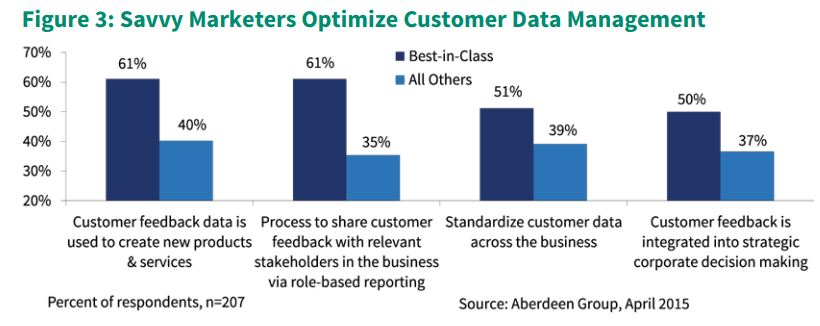
Savvy CMOs (also referred to as “Best-in-Class”) understand the importance of delighting customers. This is validated by their focus on incorporating customer feedback and behavioral data within strategic decision-making activities, an activity where they lead All Others by 35% greater adoption (50% vs 37%). By using analytical tools such as business intelligence and marketing automation, marketers are able to identify the elements of specific campaigns correlated with driving better results across key metrics such as ROMI and conversion rates. As a result, they are well-positioned to replicate successful tactics to enhance customer experiences while satisfying the shareholders through greater performance.
The ability to ensure the accuracy of business decisions based on customer data hinges on the quality of data, referring to an organisation’s ability to have an integrated and real-time view of all the customer conversations taking place across numerous channels. Once again, savvy marketers understand the importance of this capability and are therefore 31% more likely than All Others to standardise data captured across different sources (51% vs 39%). This activity allows firms to more easily integrate data captured across different channels (e.g. web, social media and email), and empowering CMOs with vital intelligence needed to personalise customer conversations — a must-have to satisfy the customers.
In addition to standardising customer data, businesses should also ensure seamless integration across enterprise systems storing this data (e.g., marketing automation and CRM). While there might be initial costs to ensure such integration, the benefits far outweigh the costs in the short-term as well as in the long-run.
Establishing a sound foundation for customer data paves the way to achieve optimal outcomes from marketing campaigns. To this point, one of the distinguishing characteristics of top performing marketing organisations is the ability to combine journey management activities with omnichannel activities. This refers to a CMO’s ability to orchestrate marketing activities in such a fashion that, regardless of the channels used to interact with buyers, each customer receives a personalised message that is tailored based on the context of previous interactions. Figure 4 shows that savvy CMOs are 52% more likely than All Others to have this capability (88% vs. 58%).
Definition:
- Omnichannel: For the purposes of this research, Aberdeen uses the term “omnichannel” to define activities that help marketers deliver personalised and consistent customer experiences across multiple channels (e.g., phone, social media, web, mobile and email) and devices (in-store, laptop and smart phone). The end goal of these activities is to ensure that the context and experience from each channel and device carries over across all other touch-points to ensure consistency of conversations via multiple touch-points.
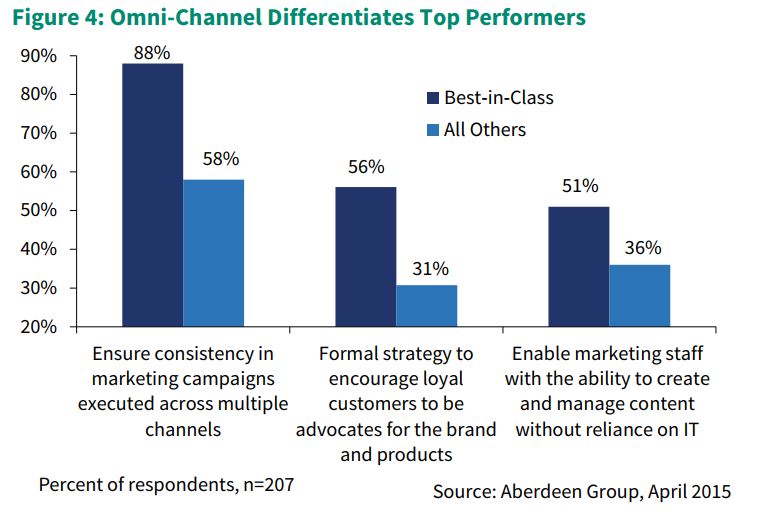
How Influencer Marketing Helps Savvy Marketers
Earlier in this article, we observed that CMOs who excel in managing customer journeys enjoy 24% greater social ‘buzz,’ compared to their competitors. Figure 4 sheds light into how they are able to conquer the hearts (and wallets) of buyers. Top performing CMOs are 81% more likely to have an influencer marketing program in place, compared to All Others (56% vs. 31%).
Influencer marketing refers to having a formal organisational program to determine the most loyal and the most influential buyers, and design targeted marketing campaigns to encourage them to share their positive experiences with their networks to acquire new buyers as well as elevate brand awareness.
Aberdeen’s March 2015 Customer Engagemant: From Interactions to Relationships study revealed that businesses successfully using an omnichannel strategy enjoy 14.6% year-over-year increase in annual company revenue and 13.0% annual improvement in customer retention rates. This compares to 10.8% year-over-year increase in company revenue and 7.7% annual increase in customer retention rates by firms without omnichannel activities. These findings validate that the top performing marketers — those who marry omnichannel and journey management — do indeed meet the differing demands of both customers and shareholders.
Relevancy and timeliness of marketing messages are key ingredients of omnichannel activities. Building and sustaining an infrastructure that allows marketers to address rapidly changing buyer needs requires CMOs to enable the marketing team with the ability to easily create, manage and update marketing content — without relying on IT. Providing marketers with relevant technology tools (e.g., content marketing and campaign management) to manage content with minimal to no coding knowledge boosts organisational ability to better align marketing conversations with buyers. Furthermore, finding from Aberdeen’s April 2014 Optimising the E-Commerce Experience: Empower Business Users to Delight Customers study shows that companies with this capability also meet the shareholders expectations of positive financial results through driving 81% greater annual increase in ROMI, compared to organisations not empowering their marketing teams (15.9% vs. 8.8%).
“CMOs must overcome certain challenges in order to satisfy customers and shareholders. When navigated smartly, the path to mitigate these challenges is a very rewarding one. To find the right path, simply follow the lead of the savvy CMOs who have already been there.”
The activities outlined thus far are vital to help modern marketing leadership to overvcome challenges in using customer data to orchestrate buyer journeys. They also help marketers ensure a tight alignment between their activities and the expectations of shareholders and customers. However, despite The Money’s traditional focus on short-term results, managing mid-to-long term marketing effectiveness is just as important to become a Best-in-Class CMO. Indeed, Figure 5 shows that savvy CMOs are 22% more likely to have established metrics to regularly gauge their performance against organisational and industry benchmarks, compard to All Others (66% vs. 54%).
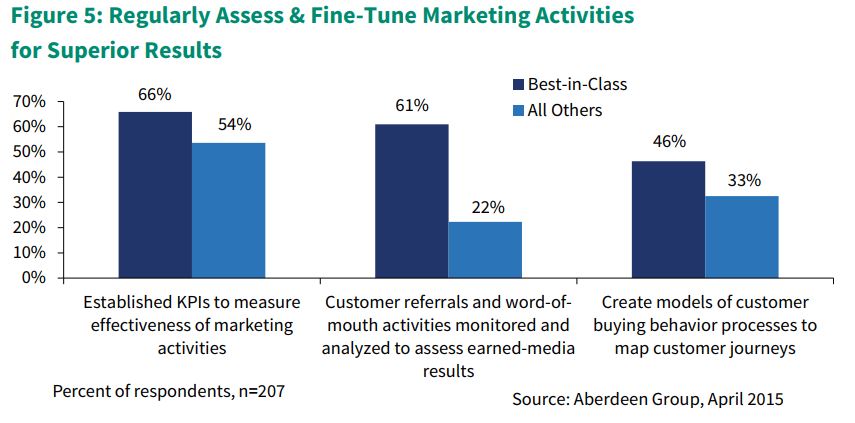
While the individual metrics used by each marketing organisation will vary based on the nature of the business and its objectives, identifying the relevant metrics to measure marketing outcomes must be top of mind for all CMOs. For, in the absence of such established metrics, marketing programs will be measured in different ways by different people, and this will make it harder to identify how each program meets expectations.
Considering that CMOs are focused to delight both the customers and the shareholders, the metrics used to gauge their results should also represent organisational success in accomplishing this goal. As such, metrics demonstrating the financial impact of marketing programs such as ROMI and average conversion rates should be a part of assessing a CMO’s performance. Companies should also incorporate metrics such as customer retention rates and customer lifetime value as they reflect a CMO’s success in understanding and addressing the needs of the customers.
How Journey Mapping Ensures Continuous Performance Improvements
Customer behaviors and expectations are very dynamic. The channels that worked to reach consumers in a particular buyer segment may no longer be appropriate after a certain time. As such, it’s critical that marketers regularly map customer behavioral activities to keep journey models for each segment up-to-date.
Best-in-Class CMOs are 39% more likely to understand the importance of this capability and make it a part of their activities, compared to All Others. Doing so helps them keep the pulse of the customers, and make appropriate modifications to track and address their changing needs.
Recommendations
Over the past decade, we’ve witnessed the role of the CMO being elevated to new heights. Marketing leaders today are expected to remain on top of and ahead of customer expectations, and be more agile than ever. While delighting the empowered customer is already a substantial challenge, CMOs must also meet the expectations of yet another key stakeholder — company shareholders.
We also noted that bridging the gap between expectations of these two key stakeholders is challenging, but not impossible. CMOs need to overcome certain challenges such as making better use of customer data to orchestrate customer journeys. However, for those who do — the Best-in-class — the rewards are substantial. Top performing CMOs enjoy far superior results in growing annual company revenue as well as satisfying and retaining their buyers, compared to competitors. In other words, these savvy marketing leaders have figured out how to meet the unique needs of the customers as well as the shareholders. If you currently struggle in accomplishing such alignment, we recommend adopting the following activities to join the ranks of these savvy marketers.
- Connect the right data and make it actionable for individual customers. The ability to successfully orchestrate a customer journey hinges on your ability to establish a comprehensive and timely view of the interactions you have with buyers across multiple channels. You must have a holistic strategy that encompasses all the data required to deliver a great customer experience. if you currently struggle with getting the most out of your existing data in your targeted marketing campaigns, consider how you currently capture, store and use data across systems such as CRM, ERP, e-commerce and web analytics. In doing so, we highly recommend integrating data from offline interactions with digital interactions as customers don’t differentiate between the two and their journey interacting with a firm often consists of both.
- Establish a single command centre to orchestrate cross-channel experiences. Aberdeen’s CEM Executive’s Agenda 2015 study shows that 100% (all) marketers are using at least two channels to interact with customers. This means that using multiple channels is no longer a differentiator, but a requirement. One of the pitfalls companies fall into when managing buyer conversations across multiple channels is the lack of a centralised system that canvases all customer interactions and helps orchestrate them. For example, are you able to coordinate your advertising activities (e.g., Facebook ads) with other cross-channel marketing programs (e.g., email campaigns)? Savvy CMOs understand how a single hub to orchestrate customer journeys helps accomplish this goal, and therefore, distinguish themselves by adopting and nurturing such a system to ensure consistency and personalisation while driving top-notch results.
- Arm your marketing team with the right tools for content excellence. As customer behavior changes, so must your marketing content in order to keep up with these changes. This requires that your marketing team is able to swiftly and easily create and change content to be used in marketing campaigns targeted to different audiences — a key enabler of success in omnichannel marketing. If your marketing team relies on others to make such changes, we highly recommend you to empower them with content creation tools that allow creating and managing relevant and timely content with minimal-to-no technical knowledge. Creating a more nimble environment will also inspire creativity with the content created; the easier it is allows for more time to think of new campaigns.
- Lay the foundation for attributing ROI, revenue, and performance to marketing campaigns. The shareholders don’t like to see short-lived performance gains. Similarly, customers don’t like to see organisations focus on their needs in the short-term and abandon them in the long-run. How do you close the loop between those two ends and drive greater ROI and value through cross-channel marketing programs? Can you identify which marketing activities drive conversions to closed business or the tie-in between offline (e.g., in-store and trade shows) and digital interactions (e.g., social media and web)? If not, then we recommend you use technology tools such as business intelligence and marketing automation to identify how each activity contributes towards such desired results. This allows answering the above questions and helps firms determine the precise resultss associated with each marketing activity.




